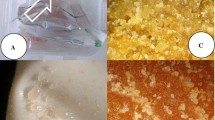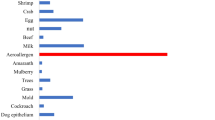Abstract
Sensitization to mites is a considerable factor in the development of allergic diseases. Because of its abundance, Tyrophagus putrescentiae (Tp) is the predominant storage mite found in home storage rooms, kitchens, and bakeries. Patients allergic to mites might exhibit a severely hypersensitive reaction upon ingesting Tp-contaminated food. The objective of this study was to investigate the rates of Tp contamination in commercial storage products from various areas, storage conditions, and environments in Taiwan. A specific antibody against Tyr p 3, the allergen on Tp, could be used as an indicator to monitor the contamination condition in storage foods. The microscopic mite examination, allergen detection by ELISA and cultured mite chemotaxis were used to evaluate the prevalence of T. putrescentiae contamination. Moreover, the IgE responses of patients allergic to mites were examined. We found that pet food and mushrooms were commonly contaminated with Tp, and this was validated through Tyr p 3 concentration and chemotaxis experiments. Tp contamination rates decreased significantly when samples were sealed and stored at a low temperature (< 4 °C), low relative humidity (RH < 60%), or for longer periods at a low temperature. The results of the clinical study indicated that the mites that elicited major positive IgE responses in allergic subjects were Dermatophagoides pteronyssinus and D. farinae. Thus, people who are sensitized to D. pteronyssinus or D. farinae might be at risk of a second anaphylactic reaction due to cross-reactivity upon ingestion of Tp-contaminated food. Accordingly, Tp contamination can be prevented by keeping food packages sealed and stored at a low temperature. This prevents the severe allergic reaction caused by the inadvertent ingestion of contaminated food-borne Tp.








Similar content being viewed by others
References
Arlian LG (1991) House-dust-mite allergens: a review. Exp Appl Acarol 10:167–186
Arlian L, Geis D, Vyszenski-Moher D, Bernstein I, Gallagher J (1984) Antigenic and allergenic properties of the storage mite Tyrophagus putrescentiae. J Allergy Clin Immunol 74:166–171
Arlian LG, Vyszenski-Moher DL, Johansson S, van Hage-Hamsten M (1997) Allergenic characterization of Tyrophagus putrescentiae using sera from occupationally exposed farmers. Ann Allergy Asthma Immunol 79:525–529
Arlian LG, Neal JS, Morgan MS, Vyszenski-Moher DL, Rapp CM, Alexander AK (2001) Reducing relative humidity is a practical way to control dust mites and their allergens in homes in temperate climates. J Allergy Clin Immunol 107:99–104. https://doi.org/10.1067/mai.2001.112119
Aygun O, Yaman M, Durmaz H (2007) A survey on occurrence of Tyrophagus putrescentiae (Acari: Acaridae) in Surk, a traditional Turkish dairy product. J Food Eng 78:878–881
Blanco C, Quiralte J, Castillo R, Delgado J, Arteaga C, Barber D, Carrillo T (1997) Anaphylaxis after ingestion of wheat flour contaminated with mites. J Allergy Clin Immunol 99:308–313
Brazis P, Serra M, Selles A, Dethioux F, Biourge V, Puigdemont A (2008) Evaluation of storage mite contamination of commercial dry dog food. Vet Dermatol 19:209–214. https://doi.org/10.1111/j.1365-3164.2008.00676.x
Bush RK Indoor allergens, environmental avoidance, and allergic respiratory disease. In: Allergy and Asthma Proceedings, 2008. Vol 6. OceanSide Publications, Inc. pp 575–579
Colloff MJ (2009) Dust mites. Springer, Dordrecht
Diette GB, McCormack MC, Hansel NN, Breysse PN, Matsui EC (2008) Environmental issues in managing asthma. Respir Care 53:602–617
Douglas AE (2015) Multiorganismal insects: diversity and function of resident microorganisms. Annu Rev Entomol 60:17–34
Duek L, Kaufman G, Palevsky E, Berdicevsky I (2001) Mites in fungal cultures. Mycoses 44:390–394
Erban T, Hubert J (2010) Determination of pH in regions of the midguts of acaridid mites. J Insect Sci 10:42
Erban T, Hubert J (2015) Two-dimensional gel proteomic analysis of Dermatophagoides farinae feces. Exp Appl Acarol 65:73–87
Erban T, Rybanska D, Hubert J (2015) Population growth of the generalist mite Tyrophagus putrescentiae (Acari: Acaridida) following adaptation to high-or low-fat and high-or low-protein diets and the effect of dietary switch. Environ Entomol 44:1599–1604
Erban T, Klimov PB, Smrz J, Phillips TW, Nesvorna M, Kopecky J, Hubert J (2016a) Populations of stored product mite Tyrophagus putrescentiae differ in their bacterial communities. Front Microbiol 7:1046. https://doi.org/10.3389/fmicb.2016.01046
Erban T, Rybanska D, Harant K, Hortova B, Hubert J (2016b) Feces derived allergens of Tyrophagus putrescentiae reared on dried dog food and evidence of the strong nutritional interaction between the mite and Bacillus cereus producing protease bacillolysins and exo-chitinases. Front Physiol 7:53
Erban T, Harant K, Hubert J (2017) Detailed two-dimensional gel proteomic mapping of the feces of the house dust mite Dermatophagoides pteronyssinus and comparison with D. farinae: reduced trypsin protease content in D. pteronyssinus and different isoforms. J Proteomics 162:11–19
Eriksson TLJ, Johansson E, Whitley P, Schmidt M, Elsayed S, van Hage-Hamsten M (1998) Cloning and characterisation of a group II allergen from the dust mite Tyrophagus putrescentiae. FEBS J 251:443–447
Eriksson TL et al (2001) Cloning of three new allergens from the dust mite Lepidoglyphus destructor using phage surface display technology. FEBS J 268:287–294
Fain A (1990) Morphology, systematics and geographical distribution of mites responsible for allergic disease in man. Mites Allerg Dis Allerbio Varennes en Argonne France
Fayaz F, Khanjani K, Rahmani H (2016) Tyrophagus putrescentiae (Schrank)(Acari: Acaridae) from Western Iran with a key to Iranian species of the genus. Acarina
Hendrix JD et al (2018) Effects of temperature, relative humidity, and protective netting on Tyrophagus putrescentiae (Schrank)(Sarcoptiformes: Acaridae) infestation, fungal growth, and product quality of dry cured hams. J Stored Prod Res 77:211–218
Hosen H (1976) The relationship of the house-dust mite to respiratory allergy. J Asthma Res 13:143–149
Hubert J, Pekár S, Aulický R, Nesvorná M, Stejskal V (2013) The effect of stored barley cultivars, temperature and humidity on population increase of Acarus siro Lepidoglyphus destructor and Tyrophagus putrescentiae. Exper Appl Acarol 60:241–252
Hubert J, Nesvorna M, Volek V (2015) Stored product mites (Acari: Astigmata) infesting food in various types of packaging. Exp Appl Acarol 65:237–242
Hubert J, Nesvorna M, Sopko B, Smrz J, Klimov P, Erban T (2018) Two populations of Tyrophagus putrescentaie differ in the response to the feeding on their feces-containing diets. Front Microbiol 9:2590
Johansson E, Johansson S, Hage-Hamsten M (1994) Allergenic characterization of Acarus siro and Tyrophagus putrescentiae and their crossreactivity with Lepidoglyphus destructor and Dermatophagoides pteronyssinus. Clin Exp Allergy 24:743–751
Johansson E et al (1999) Evaluation of specific IgE to the recombinant group 2 mite allergens Lep d 2 and Tyr p 2 in the Pharmacia CAP system. Int Archives Allergy Immunol 120:43–49
Kheradmand K, Kamali K, Fathipour Y, Goltapeh EM (2007) Development, life table and thermal requirement of Tyrophagus putrescentiae (Astigmata: Acaridae) on mushrooms. J Stored Prod Res 43:276–281
Liao E-C, Hsu E-L, Tsai J-J, Ho C-M (2009) Immunologic characterization and allergenicity of recombinant Tyr p 3 allergen from the storage mite Tyrophagus putrescentiae. Int Arch Allergy Immunol 150:15–24
Liao E-C, Ho C-M, Lin M-Y, Tsai J-J (2010a) Dermatophagoides pteronyssinus and Tyrophagus putrescentiae allergy in allergic rhinitis caused by cross-reactivity not dual-sensitization. J Clin Immunol 30:830–839
Liao E-C, Ho C-M, Tsai J-J (2010b) Prevalence of Tyrophagus putrescentiae hypersensitivity in subjects over 70 years of age in a veterans’ nursing home in Taiwan. Int Arch Allergy Immunol 152:368–377
Liao E-C, Lin Y-H, Tsai J-J (2013) Detection of group 2 dermatophagoides pteronyssinus allergen for environmental monitoring of dust mite infestation. Biosci Trends 7:82–88
Matsumoto T, Satoh A (2004) The occurrence of mite-containing wheat flour. Pediatr Allergy Immunol 15:469–471
Matsumoto T, Hisano T, Hamaguchi M, Miike T (1996) Systemic anaphylaxis after eating storage-mite-contaminated food. Int Arch Allergy Immunol 109:197–200
Ortego F, Sánchez-Ramos I, Ruiz M, Castañera P (2000) Characterization of proteases from a stored product mite, Tyrophagus putrescentiae. Arch Insect Biochem Physiol 43:116–124
Qiu X, Wang Z et al (2010) The effects of relative humidity and reducing gases on the temperature coefficient of resonant frequency of ZnO based film bulk acoustic wave resonator. IEEE Trans Ultrason Ferroelectr Freq Control 57:1902–1905
Qu S, Li H, Ma L, Song J, Hou L, Lin J (2015) Temperature-dependent development and reproductive traits of Tyrophagus putrescentiae (Sarcoptiformes: Acaridae) reared on different edible mushrooms. Environ Entomol 44:392–399
Revsbech P, Andersen G (1987) Storage mite allergy among grain elevator workers. Allergy 42:423–429
Revsbech P, Dueholm M (1990) Storage mite allergy among bakers. Allergy 45:204–208
Rybanska D, Hubert J, Markovic M, Erban T (2016) Dry dog food integrity and mite strain influence the density-dependent growth of the stored-product mite Tyrophagus putrescentiae (Acari: Acaridida). J Econom Entomol 109:454–460
Sánchez-Borges M, Chacón RS, Capriles-Hulett A, Caballero-Fonseca F, Fernández-Caldas E (2013) Anaphylaxis from ingestion of mites: pancake anaphylaxis. J Allergy Clin Immunol 131:31–35
Sanchez-Ramos I, Castanera P (2005) Effect of temperature on reproductive parameters and longevity of Tyrophagus putrescentiae (Acari: Acaridae). Exp Appl Acarol 36:93–105
Sanchez-Ramos I, Alvarez-Alfageme F, Castanera P (2007) Effects of relative humidity on development, fecundity and survival of three storage mites. Exp Appl Acarol 41:87–100. https://doi.org/10.1007/s10493-007-9052-7
Smiley RL (1984) The ordinal and subordinal names of mites with a list of the mite pests of stored products. In: Proc. third internat. working conf. stored prod. entomol. pp 36–43
Suesirisawad S, Malainual N, Tungtrongchitr A, Chatchatee P, Suratannon N, Ngamphaiboon J (2015) Dust mite infestation in cooking flour: experimental observations and practical recommendations. Asian Pac J Allergy Immunol 33:123–128. https://doi.org/10.12932/AP0484.33.2.2015
Tseng Y-H (2012) Studies on the mites in festing stored food products on Taiwan. Recent Adv Acarol 311
van Hage-Hamsten M, Harfast B, Johansson SG (1994) Dust mite allergy: an important cause of respiratory disease in farmers. Am J Ind Med 25:47–48
Vidal C, Rial A (1998) Airborne contact dermatitis from Tyrophagus putrescentiae. Contact Dermatitis 38:181–181
Vieluf D, Przybilla B, Baur X, Ring J (1993) Respiratory allergy and atopic eczema in a thatcher due to storage and house dust mite allergy. Allergy 48:212–214
White SD, Rosychuk RA, Fieseler KV (2001) Clinicopathologic findings, sensitivity to house dust mites and efficacy of milbemycin oxime treatment of dogs with Cheyletiella sp infestation. Vet Dermatol 12:13–18
Yang B, Cai J, Cheng X (2011) Identification of astigmatid mites using ITS2 and COI regions. Parasitol Res 108:497–503
Yu S-J, Liao E-C, Tsai J-J (2014) House dust mite allergy: environment evaluation and disease prevention. Asia Pac Allergy 4:241–252
Yu JM et al (2015) Diversity of house dust mite species in xishuangbanna dai, a tropical rainforest region in Southwest China. Biomed Res Int 2015:421716. https://doi.org/10.1155/2015/421716
Zhan Z-K et al (2010) Monoclonal antibodies against recombinant Der f 3 reveal localization of Der f 3 in the gut and faecal pellets of Dermatophagoides farinae. Exp and Appl Acarol 52:63–71
Acknowledgements
This study was supported by a grant (MOST 106-2320-B-715-005-MY3) from the Ministry of Science and Technology, Taiwan, Republic of China and by grants (1042A09 and 1061B26) from Mackay Medical College, New Taipei City, Taiwan.
Author information
Authors and Affiliations
Corresponding author
Ethics declarations
Conflict of interest
The authors declared that they have no conflict of interest.
Additional information
Publisher's Note
Springer Nature remains neutral with regard to jurisdictional claims in published maps and institutional affiliations.
Electronic supplementary material
Below is the link to the electronic supplementary material.
Rights and permissions
About this article
Cite this article
Shen, CY., Yen, CY., Chien, DK. et al. Influence of storage conditions on the infestation of Tyrophagus putrescentiae and prevalence of mite hypersensitivity in Taiwan. Exp Appl Acarol 80, 381–398 (2020). https://doi.org/10.1007/s10493-019-00453-6
Received:
Accepted:
Published:
Issue Date:
DOI: https://doi.org/10.1007/s10493-019-00453-6




